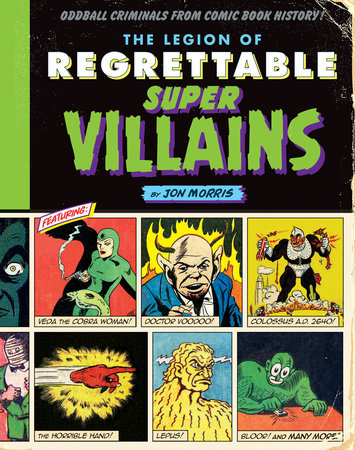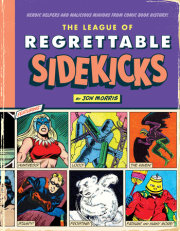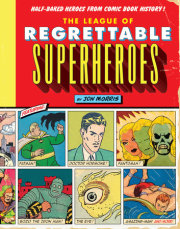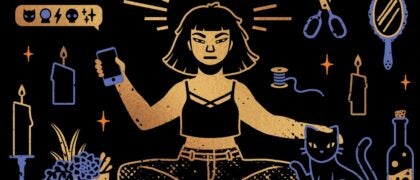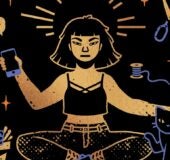IntroductionWhat good is a superhero without a decent supervillain?
It didn’t take long for the first comics creators to ask themselves that very question. While the dynamic new literary genre of the costumed crime-fighter was still cooling on the windowsill, the heroes’ opponents began to crawl out of the woodwork. Almost immediately, their ranks were tremendous and their variety seemingly limitless.
From the start, the narrative burden in superhero comics has always been on the bad guys. They need to outnumber and overpower the heroes, enact an array of schemes to provide conflict, be alluring in their appearance and modus operandi, and—most important—set the heroism of the good guys into stark relief. Some supervillains have risen to the occasion,
and their fame has grown as great as the heroes they battle. Lex Luthor, the Joker, the Green Goblin, Thanos, Ultron, Doomsday—these are household names among comic book fans, and even in the wider pop culture universe their renown is on par with that of their noble nemeses.
But those illustrious reprobates represent only the tiniest tip of the illicit iceberg of dobaddery. Within the pages of this book you will find villainy’s vilest runners-up in all their weird, wonderful glory. These are the forgotten fiends whose usually brief, and frequently fatal, careers belie a degree of wild invention—and a peculiar appeal that often makes the crook
more compelling than the hero. It’s not their fault that so many of these lurid lowlifes and repulsive rogues enjoyed only short and uncelebrated careers. After all, the hero gets the glory, even though the villain does so much of the heavy lifting.
Inside this volume you will meet wild werewolves, sensuous snake women, and avaricious alien conquerors in abundance. You’ll find such wild wrongdoers as a bioelectric brainpowered baddie, a space wizard with a nose full of lightning, and a voodoo villain dressed like a haunted chicken, just to name a handful of evil’s oddest representatives. Comics fans will recognize a few familiar and beloved—if bizarre—bad guys, including a high-hopping bundle of French clichОs, a flying cyborg head, and a hundred-foot-tall hard-boiled Communist egg.
As in the companion volume to this book,
The League of Regrettable Superheroes, we use the term
regrettable lightly. No matter the shape, size, or strategy of the four-color finks gracing these pages, every one of them had the potential to join the ranks of comicdom’s icons of iniquity. It was only poor sales, inopportune timing, and occasional overshadowing from bigger baddies that consigned so many of these scoundrels to the scrapheap of comic book history. Until now!
Read on and enjoy the colorful variety of the medium’s most forgotten foes and oddball blackguards. You’ll find your own answer to the question posed at the outset. Clearly a superhero without a decent supervillain is simply no good at all.
The Golden Age: 1938-1949When Superman debuted in 1938, he launched the immense, florid industry of comic book superheroes. His colorful foes, however, came a little later. Originally, the Man of Steel’s opponents were limited to corrupt politicians, oligarch industrialists, penny-ante gangsters, and the occasional force of nature. His immediate imitators followed suit, and superhero comics began their existence presenting a notably one-sided battle for justice.
By 1939, the Man of Steel was matching wits with the insidious Ultra-Humanite and a modest
coterie of sinister scientists. Meanwhile, his caped and crusading buddy Batman debuted in his own title confronting a homicidal harlequin called the Joker. Within a year, supervillains were as common to comics as the heroes they battled.
A hallmark of the Golden Age of comics is the era’s limitless sense of invention. The genre was
shiny, new, and utterly devoid of established rules. This was a rich playground for a wealth of imaginative authors and artists, who were required by their editors to produce continuous grist for the comics-reading mill.
Vile ventriloquists’ dummies, brutish space invaders, diabolical demagogues, disembodied
hands, avenging opera stars, femmes fatales, and murder-happy menaces populated every inch of newsprint four-color fantasies in those days. And even wilder opponents waited in the wings, with comics creators seeming eager to outdo one another with weird variations on the villainous theme.
It was an era when anything was possible, and every kind of villain—no matter how strange or unlikely—was given a shot at the good guys.
Baby Face and BrotherActs of villainy often hide behind acts of charity, and sometimes behind a bunch of bandages and a derby. That’s the story behind Baby Face and Brother, a mismatched pair of apparent philanthropists whose freewheeling ways with fat wads of cash hide their sinister agenda.
Plump and short-statured, his face contorted into a manic rictus of beaming joy, Baby Face is the derby-topped brains behind this felonious duo’s complicated scheme. His so-called Brother, by contrast, is a hulking mute wrapped in bandages from head to toe. This is a pairing that cries “menace” from every pore, but they mask their unsavory auras by freely donating to the distraught. “Ever since my brother was burned and lost his tongue,” says Baby Face unconvincingly, “we love to give out charity.” Taking to the streets, the lugubrious Baby Face hands out thick stacks of dosh to the impoverished and underprivileged. Particularly beefy subjects receive extra attention. Lured by promises of further largesse or, failing that, manhandled by Brother, suitably poor and tough-looking men are shoved into a sleek sedan and whisked off to parts unknown.
Baby Face and Brother’s antics catch the attention of the masked dogooder Twilight and his partner, a wisecracking parrot who answered to the name Snoopy a good twenty years before “Peanuts.” A curious crimefighter in his own right, Twilight was secretly Marine sergeant (and former wrestling champ) Terry Gardner. When trouble arose he would leap into battle wearing a T-emblazoned, fur-covered costume that left him looking like a long-haired werewolf.
Twilight investigates Baby Face and Brother by disguising himself as a down-on-his-luck palooka. This requires pulling a lifelike rubber mask over his fur-covered cowl, the combination of which must have smelled like a floor mat at a pet salon. Taken to a secret dungeon where the abducted men are crammed into a tiny cage and abused by Brother, Twilight uncovers the full scope of Baby Face’s evil scheme. It’s a matter of revenge—
strange revenge.
As it turns out, Brother is no tongueless burn victim. Beneath his bandages and ill-fitting green suit, the titanic brute is a snarling, vicious gorilla! Twisted by hate after years of captivity, Brother turns the tables by torturing the captive men for amusement. “For years he was teased by silly people while locked in a cage,” explains Baby Face, adding gleefully, “poke ’em with the stick like monkeys in the zoo!”
As for Baby Face, his desire for vengeance runs on similar fuel. “People poked fun at me because I was small,” he informs Twilight. For retribution, Baby Face carries a terrible weapon of his own invention: a reducing spray. “Now I’ll laugh!” he cries, demonstrating the spray’s shrinking effect on a helpless rabbit. In a subsequent scuffle, however, it’s Brother who’s struck by the shrinking formula. Enraged, the rapidly reducing ape turns on his “sibling,” brutally slashing Baby Face’s throat before being helplessly transformed into “a small, pitiful monkey.”
Freeing the prisoners, Twilight sums up the whole adventure adroitly. “What a weird sight,” he exclaims, standing over the twisted bodies of his former foes. “It all seems like a dream!”
Copyright © 2017 by Jon Morris. All rights reserved. No part of this excerpt may be reproduced or reprinted without permission in writing from the publisher.


